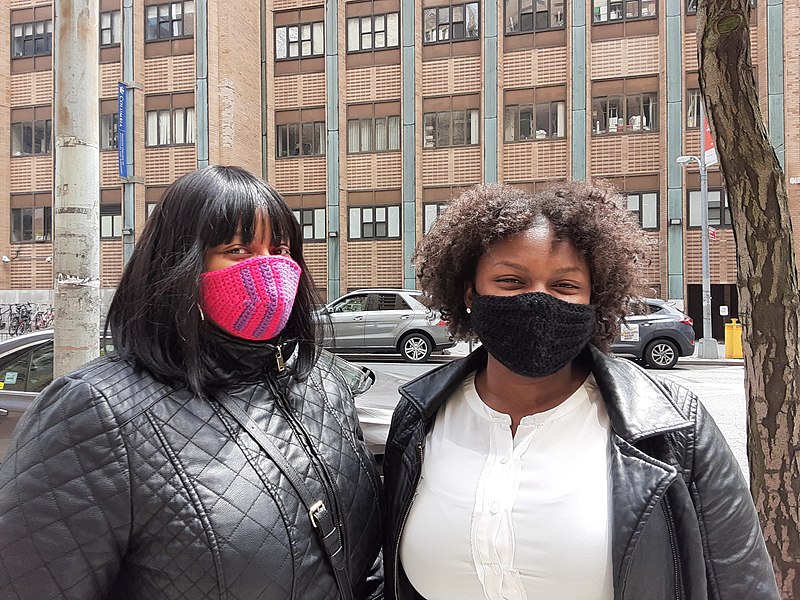
New Yorkers showing the possible ways to get creative with your masks. (Photo: Wiki Commons)
My mother says that learning to sew always skips a generation, generally spurred by the threat of war or some other world event that forces us to come together for the greater good.
I guess a pandemic would fit into that category.
My grandmother bought me a sewing machine just after I returned home from my brief 2-month stint as a freshman at Tulane, hoping to inspire and teach me the skills she had learned generations before. I was excited about making my own clothes, but as stores ran out of masks, my plans quickly changed.
I fired up my new sewing machine, fresh out of the box, and thus, my first sewing project began. I originally assumed I would only be making the masks for my small family of five, but that changed when we realized the true state of need within Colorado.
This isn’t the first time that the general public has taken up some sort of garment producing for the United States. The Knitting For Victory campaign swept through both World Wars and gave individuals who felt helpless a feeling of importance in an uncertain time. A sudden spike of women buying knitting supplies resulted in an increase in those who would pass on knitting to the next generation. There were knitting tutorials in major magazines, such as Time, making it an accessible hobby that also benefited others. Much like then, an average citizen may feel powerless with the events unfolding before us today, so I believe that making masks has helped many regain a sense of control.
Cloth-face coverings are not just a sudden trend that civilians are following to keep safe, it’s official guidance by the Center for Disease Control and Prevention and local state governments. According to the CDC, “[t]he cloth face coverings recommended are not surgical masks or N-95 respirators,” as N-95 masks “are critical supplies that must continue to be reserved for healthcare workers and other medical first responders.” Colorado’s Governor, Jared Polis, recently told the state in a press conference that anyone working needed to be wearing a mask, so the need has never been greater. Individuals also were urged to wear masks whenever traveling outside, such as to the supermarket or when in situations when it’s more difficult to maintain the 6-foot social distancing recommendation. Making masks that are easily washed, somewhat stylish, and comfortable are essential to bringing some sort of normalcy to a very abnormal situation.
The past couple of months have been difficult for many around the state of Colorado, as they feel that this time of isolation may never end. People have taken to protesting the recommendation to stay inside by going out and harassing medical workers in Downtown Denver who are trying to keep them from going out into the city, possibly infecting others. Frankly, it’s embarrassing to watch the city make national news for such a hostile and ignorant act.
I would rather that Denver make news for the wonderful people here who are working hard to keep us all safe. One of those people is Mona Lucero, a fashion designer who recently switched to making masks when the pandemic hit. “I have no experience making masks so I had to do a lot of research on how to make them, what the best type of mask would be,” expressed Lucero regarding the decision to switch to producing masks. “I realized that I would need to do that since I wasn’t able to keep my boutique doors open, and many people were approaching me to make them. It seemed like everything was pointing me that direction.”
Many fashion designers like Lucero have paused their normal activities to help produce masks including Christian Siriano, a former Project Runway winner based in New York City.
You don’t have to be a fashion designer to start making masks, however. With an almost overwhelming amount of information at our fingertips, a flood of mask tutorials became available online in the last couple of months, almost instantly. These mask tutorials weren’t strictly for people with sewing machines either. Some were hand-stitched, some were hot glued together, some tied intricately as to keep it secure. Some, like the one I followed by Denver designer Jess Hanebutt Snell, helped me learn the importance of backstitching and has given me a way to bond with my grandmother.
The creativity that has resulted from the pandemic has proven that humans are capable of coming together when faced with rough circumstances.
It is too soon to determine how masks will factor into the future of the fashion industry. For many, it’s a way to continue what they love and help their community while they do so. “Clients are asking for custom-designed masks which I’m already enjoying creating,” Lucero says of her business and if they will produce masks moving forward. “If you love what you do, you’ll do it no matter what. That’s how you know you’ve found your calling.”
 NOLAbeings
Multimedia artist Claire Bangser created NOLAbeings as a portrait-based story project that marries...
NOLAbeings
Multimedia artist Claire Bangser created NOLAbeings as a portrait-based story project that marries...
 Data corner: Adobe Suite (create a PDF, social media graphic, presentation, edit a photo and video
Data corner is where you go to work with analytics and top tech skills. It takes on everything from PERL and SQL to Canva and Sprout Social.
Data corner: Adobe Suite (create a PDF, social media graphic, presentation, edit a photo and video
Data corner is where you go to work with analytics and top tech skills. It takes on everything from PERL and SQL to Canva and Sprout Social.
